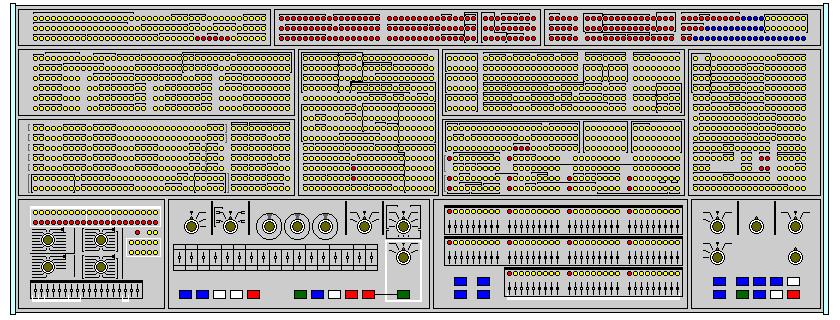
This page covers the models of the IBM System/360 that were introduced after the initial debut of the series.
The IBM System/360 Model 91 was announced in November 1964, just a few short months after the introduction of System/360. This computer, like the Model 75, was hardwired. Also, it included what is sometimes called superpipelining; that is, instead of just overlapping fetch and execute cycles, it split the execute cycle into several parts.

Just below and to the right of this main front panel, the controls here, found on most System/360 front panels, were on the body of the unit on top of which this angled control panel sat.
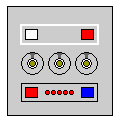
Almost the same front panel appeared on the System/360 Model 195 which had pipelining, cache, and a floating-point multiply unit that operated on multiple bits at once for speed, all just about like a Pentium, (but the Pentium used SRT division, not Goldschmidt division), and the System/360 Model 95. The 95 was almost identical to the 91, except that its main memory was a thin-film memory, giving it a speed advantage; the thin-film memory had a cycle time of 120 nanoseconds; the computers had one megabyte of this as main memory, and four megabytes of the same regular core memory as used in the model 91, at 780 nanoseconds cycle time, used as bulk core. (The memory in the model 91 had a cycle time of 750 nanoseconds; it was slowed down in the 95 so that both cycle times would be multiples of 60 nanoseconds. The cache in the model 195 had a cycle time of 54 nanoseconds, so the main memory only had to be slowed down to 756 nanoseconds in that machine.) For comparison, for other models in the IBM System/360 series, bulk core was provided in the form of the IBM 2361 large-capacity storage unit, with an 8 microsecond cycle time.
Only two IBM 360/95 computers were made, both for NASA. One went to the Goddard Space Flight Center, in Greenbelt, Maryland, and the other went to the Goddard Institute for Space Studies, part of Columbia University, in New York City. According to IBM's 360 and Early 370 Systems by Pugh, Johnson, and Palmer, IBM produced fourteen Model 91 computers, four of which it kept for internal use. At least one source estimates that about 25 Model 195 computers were produced.
While the internal logical design of the System/360 Model 195 was also closely based on that of the Model 91, it was implemented using monolithic integrated circuits, as were later used with System/370, and there even are examples of the Model 195 that have black front panels instead of light grey ones, like the System/370 as well. The Model 85 was also implemented with monolithic integrated circuits: all the other System/360 computers were integrated circuit computers, but the integrated circuits were made using IBM's Solid Logic Technology, where tiny chips containing a single transistor or other electronic component were placed within a type of multichip module. In 1964, when System/360 was introduced, monolithic integrated circuits did not offer a cost/performance advantage over discrete transistors; thus, most of IBM's competitors continued to use discrete transistors for several more years. Integrated circuits did offer a reliability advantage, and due to the large scale of IBM's operations, it was able to exploit the intermediate technology of SLT which was right for the time.
Again according to Pugh, Johnson, and Palmer, only about 30 IBM 360/85 computers were sold, this being attributed to a recession in progress at the time of its introduction. This computer was microcoded; it wasn't, for example, a model 75 with cache added. The primary front panel of this machine was like that later used on the System/370 Models 165 and 168; microfilm was used to optically overlay a panel of lights, next to a similar-looking microfilm reader for documentation.
The 360/195, combining the benefits of cache memory with the design features of the Model 91, was a particularly powerful machine in its day. At least three were sold in Britain, one to the Met Office, and two, operated together, to the Rutherford Appleton Laboratory; in the United States, the NOAA, Argonne, and Oak Ridge were among its users. Some 360/195 computers were sold with black front panels, like those of System/370, and a later upgraded version, the 370/195, incorporating System/370 extensions to the instruction set, was also produced. The 360/195 and the 370/195 appear to have been the most popular members of this family.
This front panel was separate from the cabinets which contained the circuitry of the computer, connected to the computer proper by wires that travelled under elevated flooring.
Also announced in November 1964 was the System/360 Model 20. This computer was not fully compatible with the System/360 design, in that it only had eight general registers, numbered from 8 to 15, and they were 16 instead of 32 bits long. This computer, designed by IBM's German branch, was aimed at users with modest budgets.

This wide front panel was above the computer, which was a very compact unit compared to other models in the System/360 series.
In August, 1965, IBM introduced the Model 67 computer, which looked like the Model 65, as it was simply a modification of the Model 65 that included hardware for Dynamic Address Translation, useful in time sharing.
Also announced in that month was the IBM System/360 Model 44 computer. This member of the System/360 family was specialized for scientific and process control applications, and was unusually economical for its power as a scientific computer.
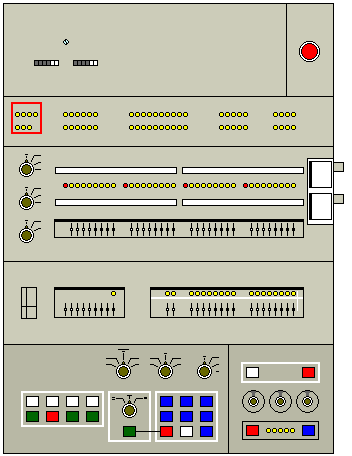
The actual front panel of the Model 44 is illustrated by the diagram shown above. Early advertising material for this model shows a prototype with a significantly different front panel arrangement, although that prototype did reflect some of the unique features of the actual Model 44 front panel.
So that this prototype might be recognized if encountered in photographs without additional information, here is a depiction of its front panel as well:
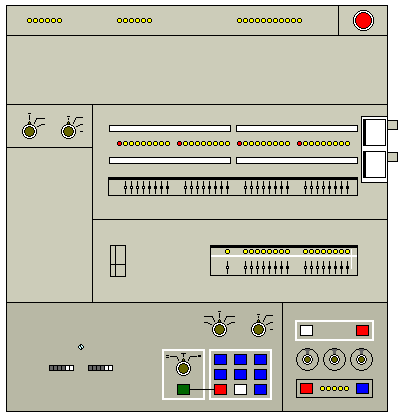
In January, 1968 a fully compatible member of the System/360 family was introduced for those seeking something even more economical than the Model 30 but unwilling to accept the limitations of the Model 20; the System/360 Model 25.
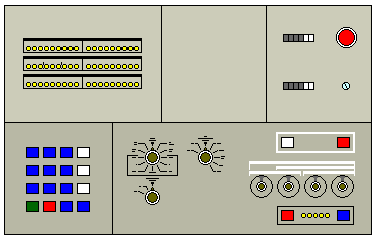
Its front panel was quite modest in size, and so it didn't reach to the top of the mainframe behind it.
The front panel of the System/370 Model 115 appears to have some resemblance to that of this model, but I have as yet no additional information indicating a connection between them.
Also introduced in that month was the System/360 Model 85 computer. This computer had a 108-bit microcode word, and was not hardwired, but despite this it performed very nearly as well as the Model 91, which had been discontinued shortly before its introduction. This computer was the first to use a high-speed cache memory to allow the computer to run as if all of main memory ran at the speed of the cache.
More information about this computer, and a picture of its front panel, will be found on the next page.
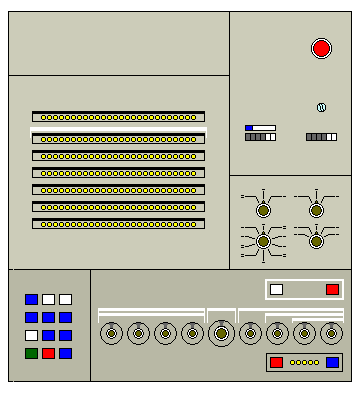
After the first models in the System/370 line were announced, IBM added one low-end machine to the System/360 family, the Model 22, which was based on the Model 30, one of the original members of the 360 family: